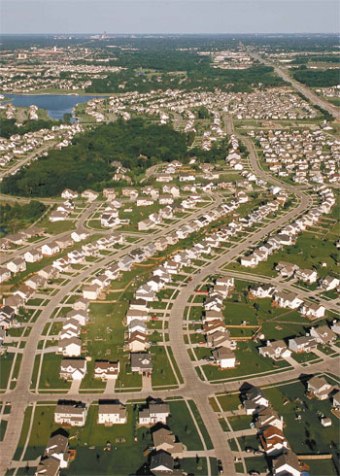My last blog post was a bit of a rant about Viera and other “New Towns” and how they’re sprawl on steroids. I might be appearing somewhat harsh. Viera is indeed a form of sprawl, but it also really is a cool place. It’s pretty, and it has many nice things about it that I really like. The town center is one of the nicer places to go shop or hang out around here. I especially like the little plaza in the middle with the fountain and how a couple of the restaurants have some nicely shaded outdoor seating areas back there. I like the plaza in front of the movie theater and I like the landscaping and wide sidewalks. The new hospital in Viera looks really nice, and the new county offices out there are just gorgeous. Overall the community is pretty nicely done in relative terms. But it could have been and still could be so much more. Firstly, this development should have never happened in its location. We should have stopped our outward migration long before this and maybe only allowed little hamlets to be built out there in a way that truly honors the context. This would have benefited our entire region so much better. But we built it and it’s there. It’s a beautiful place, and the fact that it was the wrong place to build it now really is water under the bridge.
The question is, what do we do from this point? I suggest that we must draw a line in the sand and say, “This far, and no farther!” We do have some lines like that, to some extent, already. There are big conservation areas way out there beyond Viera that have been officially and legally protected. What about all the open land this side of those areas? What about land in our county that lies even further out on the other side of our designated conservation areas? We must institute a land conservation policy that is clear and makes clear stipulations about how the remaining open land in our county can be developed, if at all. The SmartCode (www.smartcodecentral.com) gives us a couple of options that are not in our current codes – Growth Zones and Community Types. See, truly sustainable development must be based on walkable communities. In the SmartCode there are 3 basic walkable community types: 1) the “Regional Center”, 2) the “Traditional Neighborhood”, and 3) the “Clustered Land Development” (a.k.a. the “Preservation Hamlet” or just “Hamlet”). The Growth Zones in the SmartCode are O1, O2, and G1 thru G4. O1 being “Conservation”, areas already legally protected from development, all the way up to G3 “Intended Growth”, and G4 “Infill” (those areas already developed).
The G1 “Restricted Growth” zone would be assigned to those areas like around Viera that aren’t protected but are of a rural character and too far away from existing development to warrant higher intensities. In this zone only Hamlets would be allowed. These are small walkable rural communities of 30-80 ac in land area which would have a very small commercial center and a small number of homes arranged in a walkable cluster. In a local implementation of the SmartCode we would stipulate that the community be surrounded by an appropriate acreage of land that would then be officially preserved as wilderness or for agriculture. This allows for some development in these outlying areas, but prescribes that it be done in a way that is appropriate for it’s context.
Why worry about this so much? Why limit the development land owners can do on their rural land? Well, just imagine how different it would have been if the county offices wouldn’t have been moved to Viera? How much healthy activity could have been generated in West Cocoa if they had been put there instead? How much wealth and investment has been siphoned off to Viera that could have gone toward improvements in cities like Titusville? Could the Miracle City Mall have been redeveloped into something wonderful surrounded with beautiful new homes to give a shot in the arm to that struggling town? Yes! Think about it. We must draw the appropriate lines in the sand now! “This far, and no farther!”
Barry Watkins, Email: walkablebrevard@gmail.com, Ph: 321-355-2747
Please join Walkable Brevard in our efforts to be a positive influence on our local regulatory environment. Come and “Like” our Facebook page at www.facebook.com/WalkableBrevard and check back often to see what’s happening in your community. You may also email or call Barry Watkins using his contact information above to find out more.

Does the capacity of the water + sewer system not pre-determine that ‘line in the sand’, or does the county/municipality continue to invest inline with the development?
LikeLike
Yes, that’s part of the equation. It hasn’t been enough because whenever a developer is willing to pay for their own infrastructure improvements the local governments have been happy to allow way too many units. Local regulators have attempted to require some “smart growth” design on the rural fringe in our county, but it’s a very watered-down version and still very car-dependent/-dominant. Adopting a county-wide SmartCode would be a much more detailed and targeted regulation that would require walkable communities. That’s what I’m working to have adopted here. –Barry
LikeLike